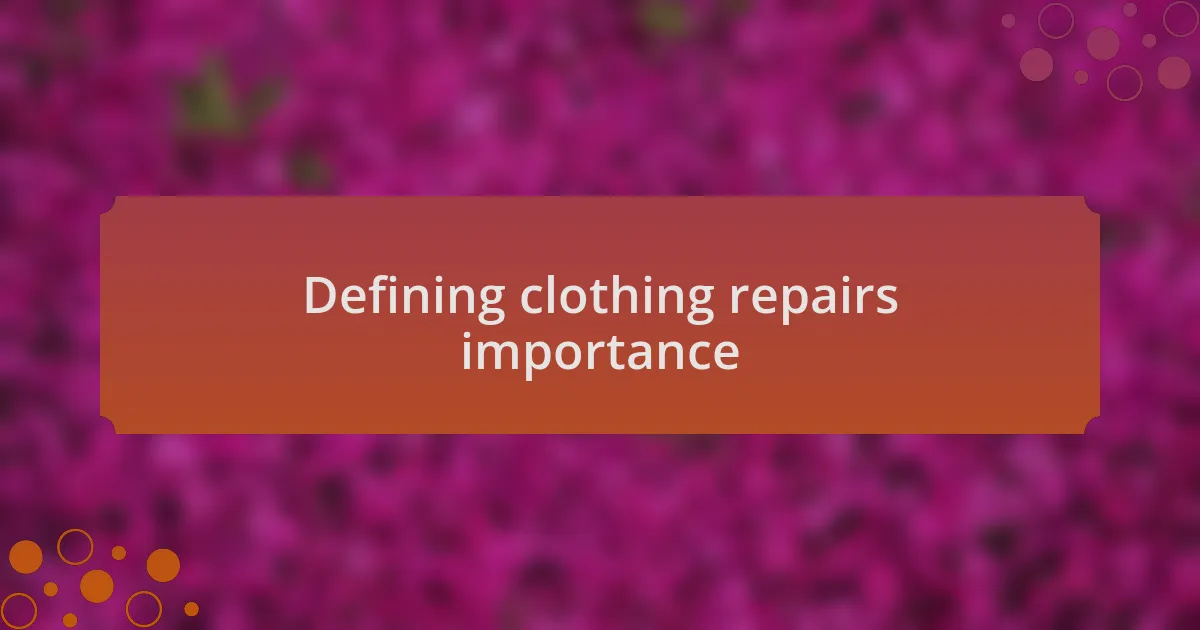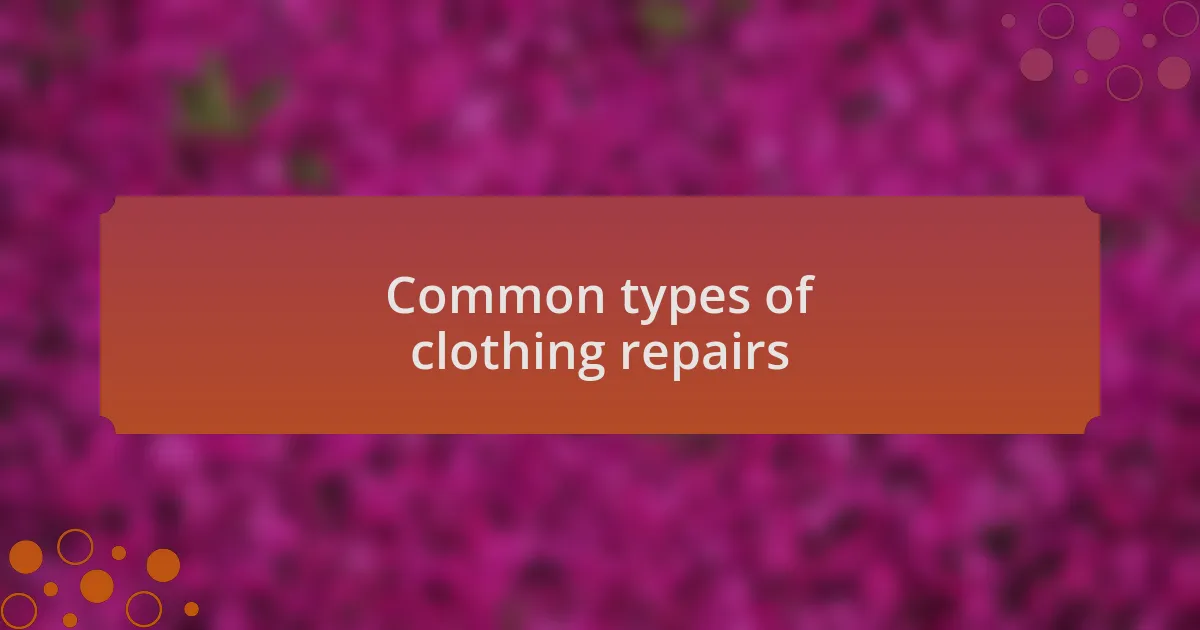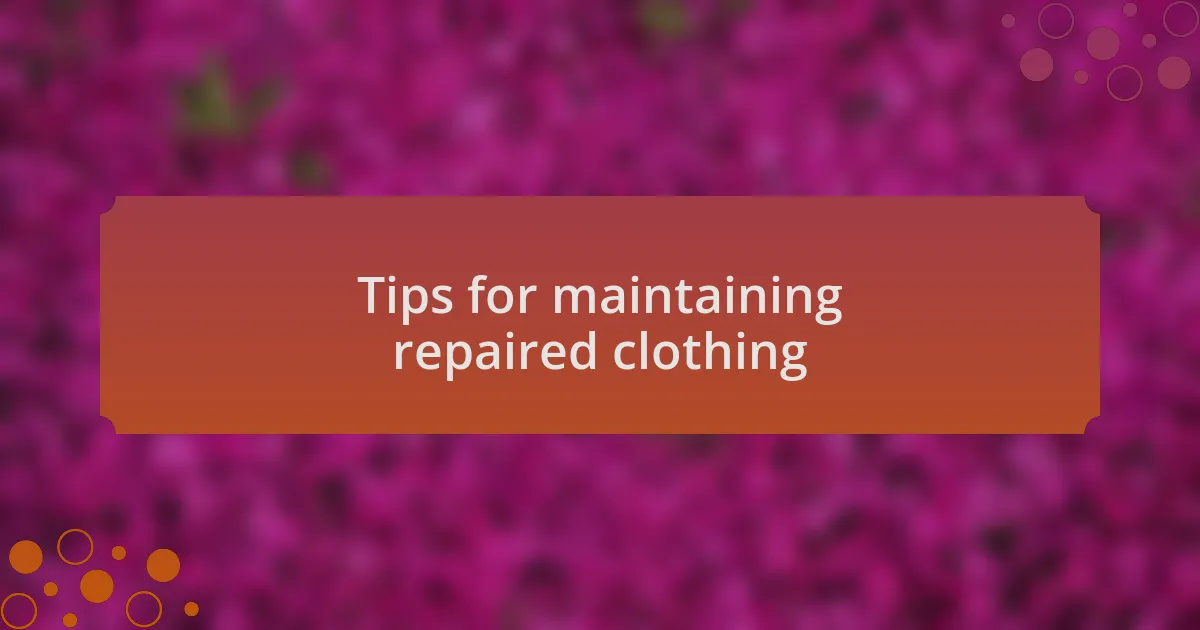Key takeaways:
- Clothing repairs cultivate sustainability by reducing waste and fostering a deeper connection to garments.
- Common repair techniques include mending seams, replacing buttons, and patching holes to prolong the life of clothing.
- Utilizing the right tools and techniques, such as backstitching and zigzag stitching, enhances the durability of repairs.
- Proper maintenance, including washing inside out and avoiding dryers, is essential for preserving repaired clothing.

Defining clothing repairs importance
Clothing repairs may seem like a minor task, but they play a vital role in prolonging the life of our garments. I remember a time when I nearly tossed a favorite jacket after a small tear. Instead, I decided to patch it, transforming what could have been waste into a beloved reminder of my resourcefulness.
When we address repairs, we’re not just fixing clothes; we’re cultivating a mindset of sustainability. Think about it—every time you choose to mend rather than replace, you’re reducing waste and contributing to a more mindful consumption pattern. It’s a small step, yet it carries significant weight for the environment and our wallets.
For me, each repair is an opportunity to connect with my clothing on a deeper level. It’s like a nurturing relationship; each stitch reflects care and attention, turning a simple piece of fabric into part of my story. Have you ever felt that way about an item you fixed? I find it rewarding to see the tangible results of my efforts, knowing I’ve made a conscious choice that fosters both creativity and sustainability.

Benefits of effective clothing repairs
Effective clothing repairs offer an opportunity to save money and resources. I remember the first time I repaired a pair of jeans that had a frayed hem. The cost of professional alterations would have been higher than I anticipated, but learning to fix it myself not only saved me cash but also gave me a sense of accomplishment. Have you ever realized just how much you can save by taking a few minutes to repair something rather than buying new?
Additionally, each successful repair strengthens our connection to the garments we wear. I often find that a well-mended piece becomes more than just clothing; it turns into a cherished memory. For instance, I once stitched up a vintage dress that belonged to my grandmother. Every time I wear it now, I can feel her presence, making it far more than just a dress; it represents family history and love.
Lastly, embracing the process of clothing repairs fosters creativity. Each challenge becomes a canvas for personal expression. When I face a stubborn tear or a loose button, it sparks my creativity to try unique fixes, like decorative patches or colorful threads. Isn’t it fascinating how everyday tasks can morph into an opportunity for self-expression? This approach not only revitalizes old clothing but also transforms the mundane into something extraordinary.

Common types of clothing repairs
When it comes to clothing repairs, some common types include mending seams, replacing buttons, and patching holes. For instance, I recall a winter coat that had a small tear near the pocket. Instead of tossing it aside, I simply stitched it up, and the coat returned to its former glory. Have you ever thought about how a tiny stitch can extend the life of your favorite pieces?
Another frequent repair is dealing with hems, which can easily fray over time. I recently handled the hem of a beautiful skirt I loved but hadn’t worn in a while because it was dragging. A quick and careful fold and a few stitches later, it was ready to be part of my wardrobe again. Isn’t it remarkable how something so simple can bring back the joy of wearing a beloved item?
Moreover, tackling loose threads and uneven hems can prevent bigger issues down the line. I’ve learned from experience that ignoring these little problems often leads to more significant damage, which can feel disheartening. So, I’ve made it a point to address small repairs immediately. After all, isn’t it more gratifying to maintain what you love rather than facing a wardrobe crisis later?

Tools for successful clothing repairs
Having the right tools at your fingertips makes all the difference in successful clothing repairs. I remember starting with just a basic sewing kit, which seemed adequate. However, I quickly realized that a good pair of fabric scissors and a seam ripper became essential companions. Scissors allow for clean cuts when adjusting fabric, while a seam ripper helps effortlessly undo mistakes. Have you ever struggled with removing a stubborn stitch? Trust me, having the right tools can simplify that process.
A reliable needle and thread selection is another key element. I’ve found that using high-quality strands not only makes my repairs more durable but also gives me peace of mind that my work will withstand the test of time. I still recall repairing a favorite sweater with some thread that I thought was sufficient, only for it to unravel after a few washes. Choosing the right needle size for the fabric can also prevent unnecessary damage. Isn’t it funny how a small detail, like a needle, can make such a big impact?
Lastly, don’t underestimate the power of an iron or fabric glue. I often use an iron to press seams flat, which gives my repairs a professional touch. I remember fixing a shirt where I needed to smooth out the altered hem. Ironing it out made all the difference in appearance. Fabric glue is also handy for quick fixes; once, I used it to secure a patch on a backpack that was fraying. How rewarding it is to see a once-tattered item restored with just the right tools!

Techniques for repairing clothing
When it comes to repairing clothing, I’ve found that learning simple stitching techniques can dramatically enhance the durability of my repairs. For instance, the backstitch is my go-to for areas that face wear, like the hem of my jeans. It’s robust and, honestly, once you get the hang of it, it almost feels like an art form. Have you ever noticed how much more secure a backstitched seam feels compared to a basic running stitch? That little difference can extend the life of your favorite garments.
For smaller issues, I often turn to patching as a creative solution. I vividly remember giving new life to an old jacket by adding some fun fabric patches. Not only did it cover a tear, but it also transformed a tired item into something fresh and unique. Patching can be a fun way to express your style, right? It’s like giving your clothing a new narrative, turning a tear into a statement.
On the technical side, I’ve learned that reinforcing frayed edges before they become larger issues is crucial. I typically run a zigzag stitch along the raw edges. Initially, I was hesitant, thinking it might look too homemade, but it turned out to be a game changer. Now, every time I wear those items, I feel a sense of pride, knowing I’ve taken proactive steps to preserve them. Don’t you agree that prevention can often be easier—and more satisfying—than waiting for a problem to arise?

Personal experiences with clothing repairs
When I was in college, I faced a wardrobe crisis when my favorite sweater developed a small hole. Instead of tossing it, I decided to try my hand at darning, a technique I had heard about but never attempted. As I meticulously stitched the hole, I felt a wave of satisfaction. That moment taught me not just a skill, but the value of patience and creativity in preserving what I love.
On another occasion, I was invited to a friend’s wedding, and my go-to dress developed a snag just hours before the event. In a panic, I grabbed some fabric glue, and it worked wonders! Although it wasn’t a detailed repair, the quick fix saved the day and got me thinking: sometimes, less is more. Have you ever had a similar last-minute fix that turned into a fantastic solution?
Repairing clothing has had its ups and downs for me. I recall attempting to fix a zipper on my favorite jacket, only to have it snap completely during the process. I took a deep breath and turned it into an opportunity to try a button-up style instead. The unexpected change made me realize that repairs can also lead to new creative directions in fashion. Who knew a zipper malfunction could lead to a fresh look?

Tips for maintaining repaired clothing
Taking care of repaired clothing is essential for ensuring that your efforts don’t go to waste. After I patched a beloved pair of jeans, I made it a point to wash them inside out and in cold water. This not only protects the repair but also slows down the fading process. Have you noticed how clothes can look brand new after just a little extra care?
Another tip I’ve found invaluable is to avoid the dryer whenever possible. I learned this the hard way when a repaired shirt shrank slightly after a tumble dry. Now, I hang my clothes to dry, which helps preserve both the fabric and the repairs I’ve worked so diligently on. It’s such a small change, but it’s made a world of difference!
Finally, regularly check on your repairs. I once let a repair go unnoticed and only realized that it needed reinforcement after a week of wear. By keeping an eye on your handiwork, you can catch any issues early and either fix them yourself or seek professional help, ensuring that your clothing remains as good as new. Have you had a moment where a quick inspection saved a favorite piece? It’s those small efforts that really pay off!